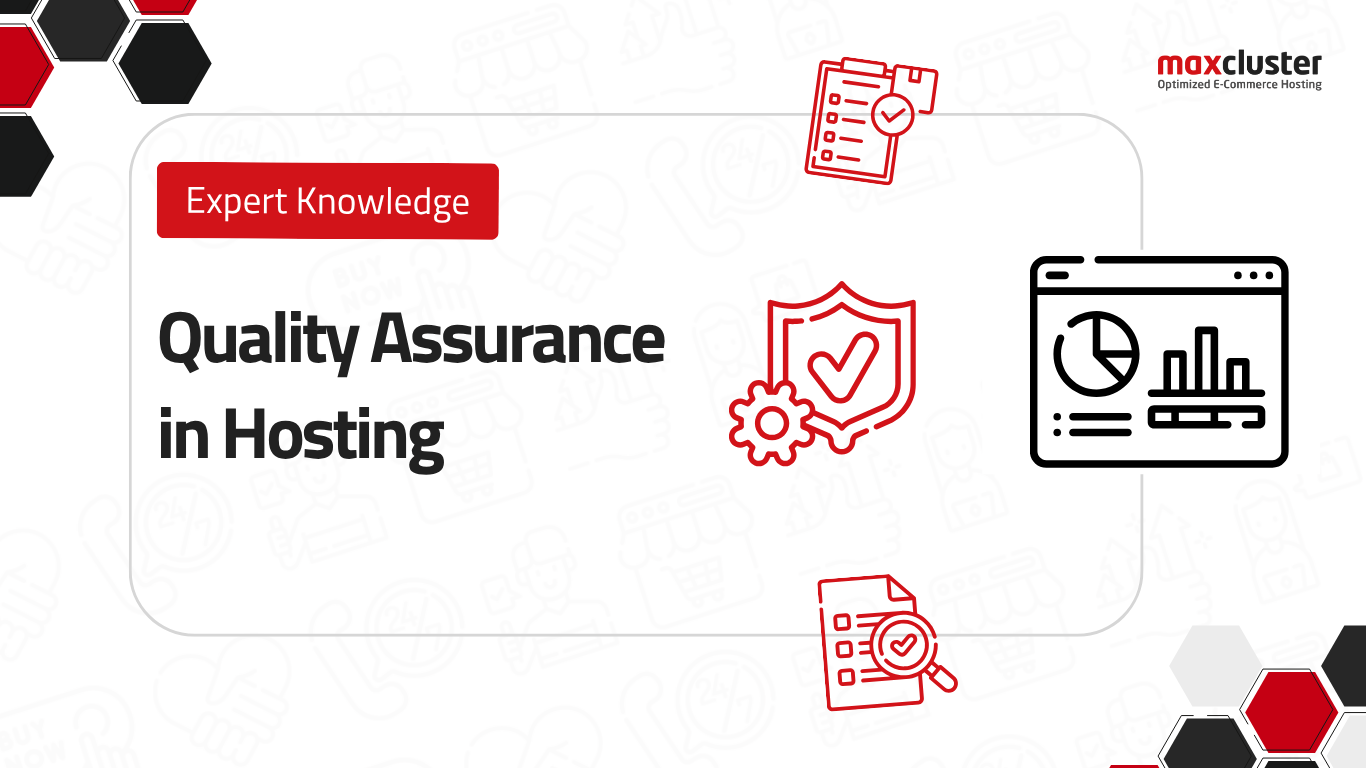
TL;DR – The most important facts in 30 seconds
Quality in hosting is not a nice-to-have – it’s a business-critical factor:
- Cost factor: 90% of companies report that just one hour of unplanned downtime costs more than €280,000—in retail, the average is often around €900,000.
- Customer expectation: 77% of buyers abandon their purchase immediately if a shop crashes. 60% never return—resulting in lost revenue and customer loyalty.
- Quality assurance according to ISO: ISO 9000:2015 defines QA as a process that builds trust through standards, control, and continuous improvement.
- How maxcluster works: 24/7 monitoring, automated testing, CI/CD pipelines, clean code principles, and transparent Q reports.
- Added value for e-commerce: Fewer outages, stronger security, faster loading times, and sustainable innovation—enabling online shops to grow reliably.
Why is quality so crucial in hosting?
In digital commerce, the quality of your hosting environment determines whether you make sales or lose revenue. Every outage, every second of delay at checkout, and every security breach has direct economic consequences.
- Security incidents are more expensive than ever: The global average cost of a data breach in 2024 was around €4.5 million—a significant increase from around €4.1 million in 2023. This is the highest jump since the pandemic and includes downtime, lost business, and post-breach measures, among other things (source: Table Media, IBM Cost of a Data Breach Report).
- Downtime eats up budgets by the hour: According to ITIC 2024, one hour of unplanned downtime costs 90% of companies over €280,000; 41% estimate the damage at around €900,000 per hour (source: ITIC).
- Particularly critical in commerce: observation data shows that highly critical failures cause a median of around €1.75 million per hour; even with a “medium” impact, the costs are still around €1.5 million per hour (source: New Relic).
- Macro perspective: At the Global 2000 company level, unplanned outages add up to around €370 billion per year (≈ 9% of profits)—a massive lever for prevention, observability, and resilience (source: Splunk).
Hosting quality is critical to business. Only a stable, secure, and high-performance infrastructure enables customers to shop reliably—regardless of traffic peaks, releases, or maintenance windows.
It forms the basis for growth, trust, and sustainable innovation.
The four dimensions of quality assurance
| Dimension | Goal | Examples |
|---|---|---|
| Stability | Systems run reliably – even under load | Highly available infrastructure, failover concepts, redundancy |
| Security | Protection against attacks and misconfigurations | Regular patches, penetration tests, access controls |
| Performance | Fast loading times and scalable resources | Caching, optimized databases, load balancing |
| Transparency | Traceable processes and clear key figures | Monitoring, reporting, Q reports with traffic light logic |
These four pillars form the foundation of quality assurance at maxcluster—technically, organizationally, and culturally.
They ensure that quality does not arise by chance but through clear processes, continuous monitoring, and active responsibility.
What do we mean by quality assurance?
Quality assurance (QA) accompanies the entire life cycle of your shop—from planning and development to ongoing operation.
It ensures that systems, processes, and applications remain stable, secure, and performant over the long term.
In the context of hosting, this means identifying risks early on, creating structures, and making reliability measurable.
Key objectives of quality assurance
- Define standards: Clear guidelines for code, processes, and infrastructure.
- Establish measurability: Create transparency through KPIs, reports, and monitoring.
- Detect errors early: Identify problems before they affect productive operations.
- Empower teams: Training, documentation, and clear responsibilities.
- Continuously improve: Understand quality as an ongoing learning process—not a one-time audit.
ISO 9000:2015 describes quality assurance as a process that builds trust through repeatable procedures, reliable standards, and traceable results.
Why quality assurance in hosting is essential
In e-commerce, even a small deviation has a direct impact on sales and reputation.
An untested change, an unstable server, or a faulty configuration can lead to failures—with direct consequences for customer satisfaction and conversion.
The figures underscore the risk:
According to Queue-IT, 77% of users immediately abandon their purchase when an error occurs, and 60% do not return (source: Queue-IT).
Sustainable quality can only be achieved through the interaction of technical and organizational measures.
- Technical stability: Automated testing, monitoring, and backups ensure that systems run reliably and errors are detected early.
- Organizational quality: Clear processes, documentation, and training promote transparency, accountability, and continuous learning within the team.
Both dimensions are intertwined—quality only becomes reliable when processes are documented, reviewed, and continuously improved.

Quality assurance at maxcluster—how we work
At maxcluster, quality assurance is not a one-time project, but a continuous process—from development to operation to ongoing optimization.
It is based on clearly defined processes, proven technologies, and a culture of responsibility in which every team member actively contributes to stability, performance, and security.
Our principle is: proactive rather than reactive.
We rely on automation, testing, and knowledge transfer to identify problems early on, learn from experience, and improve systems in a targeted manner.
Proactive monitoring & supervision
E-commerce systems must function reliably day and night—even brief interruptions have a direct impact on sales and trust.
That's why we monitor our platforms around the clock: automatically, transparently, and with clear escalation paths.
| Area | Description | Benefit |
|---|---|---|
| System metrics | Monitoring of CPU, RAM, I/O load, network traffic, and storage utilization | Early detection of load peaks or resource conflicts |
| Security parameters | Analysis of anomalies, log irregularities, and login attempts | Protection against attacks and abuse |
| Service checks | Monitoring of critical services (web servers, databases, caching systems) | Minimization of downtime |
| Application level | Monitoring of shop performance, API response times, and database connections | Direct impact on user experience |
If metrics exceed defined thresholds, the responsible team is notified immediately.
Thanks to structured processes, response times are measured in minutes.
Every incident is documented and results in a new test ticket—a cycle of experience, analysis, and improvement.
Standardization & automation
Standardization is a key factor in ensuring stable hosting quality.
It reduces sources of error, creates reproducible results, and ensures consistently high performance.
Our standards in practice:
- Standardized hosting setups for Shopware, Magento, and WooCommerce—optimized for e-commerce workloads.
- Automated test runs in CI/CD pipelines: Faulty deployments are blocked until all tests are passed.
- Continuous integration & deployment: Updates and new features are securely integrated and delivered.
- Static code analysis with tools such as SonarQube for security, readability, and compliance with clean code profiles.
Advantage:
Automated processes minimize human error, shorten release cycles, and ensure consistently high quality—while enabling rapid innovation.
Proprietary tools and continuous development
For us, quality means continuous development. That's why we develop our own tools and regularly evaluate new technologies in order to optimize our platform in a targeted and sustainable manner.
Our approach to development and optimization:
- Performance monitoring at shop level for early detection of bottlenecks.
- Test environments for new technologies.
- Automated regression tests with ticket creation in case of errors.
- Feature coverage & test automation: Every new feature is fully tested and documented.
- Insights gained from operations and projects are systematically fed back into product and process improvements—this ensures that QA remains measurably adaptive.
Customer feedback and support quality
Quality does not end in the data center—it is also evident in dialogue.
That is why we combine technical excellence with direct, competent communication.
- Direct access to experts: no hotline ping-pong, just fast, informed help.
- Feedback as a source of learning: every inquiry is documented and evaluated; recurring topics are incorporated into process improvement.
- Regular training: our support team always stays up to date on the latest technical and security developments.
Documentation & knowledge transfer
Our documentation makes quality traceable: every change, every test, and every optimization is systematically recorded and shared across teams.
| Area | Description | Goal |
|---|---|---|
| Test documentation | Recording of all test runs with parameters and results | Reproducibility and traceability |
| Playbooks & best practices | Standardized procedures for recurring tasks | Time savings and consistent quality |
| Internal knowledge transfer | Knowledge sessions, internal wikis, peer reviews | Continuous learning within the team |
| Onboarding & training | Structured onboarding of new team members | Fast integration without loss of quality |
This ensures that knowledge is actively shared, documented, and integrated into daily work—a culture that guarantees quality in the long term.

What makes our quality special?
Quality at maxcluster is the result of the interplay between technology, processes, and responsibility.
What sets us apart is the consistent combination of technical excellence with organizational precision and a culture of responsibility that is put into practice.
Our goal: not only to comply with standards but to continuously develop them further—with measurable added value for you and your shop.
Technology and processes—our quality cycle
Quality and efficiency go hand in hand at our company.
Results from builds, tests, and monitoring are incorporated into the Q-Report and drive prioritized improvements—from identification to implementation.
At the same time, clear processes, documented procedures, and feedback loops ensure that technical and organizational quality are intertwined.
The result is a learning system that improves with each iteration.
Clean code as a basic principle
Clean code is the foundation of our technical quality.
It stands for structure, clarity, and sustainability—qualities that determine success or failure in e-commerce.
Our guiding principles:
- Consistency: Uniform standards in all projects—from code style to database structure.
- Clear intent: Every line of code has a clear purpose; unnecessary complexity is avoided.
- Adaptability: Systems grow with us—technically and commercially.
- Responsibility: Every developer actively contributes to code quality—regardless of role or hierarchy.
Automated code reviews and static analyses technically ensure these principles. Clean code reduces maintenance costs in the long term, increases stability, and makes innovation plannable.
Responsibility instead of a culture of error
Mistakes are part of learning—how we deal with them is what matters.
At maxcluster, we live an open culture of responsibility in which every team member contributes to improvement.
- Transparent communication: Every incident is documented, analyzed, and converted into test cases.
- Cross-team collaboration: Development, operations, support, and product management share knowledge and experience.
- Personal responsibility & trust: Teams make their own decisions—and take responsibility for the results.
This creates an organization that responds quickly, acts resiliently, and understands quality as a common goal.
Sustainable quality instead of quick fixes
Short-term solutions can help, but sustainable quality comes from consistent development and long-term optimization.
We rely on an approach that combines technical excellence with stability and future-proofing.
Our approach:
- Cause-oriented bug fixing instead of merely remedying symptoms.
- Regular modernization of older systems and technologies.
- Continuous expansion of automated testing and documentation.
This makes our hosting environments more robust, efficient, and cost-effective with each iteration—a foundation on which sustainable growth is possible.
Measuring quality – KPIs & reporting
Reliable quality requires clear metrics.
That is why quality assurance at maxcluster is based on objective key performance indicators (KPIs) that show how stable, secure, and efficient systems really are.
These values make progress measurable—and enable targeted optimizations instead of subjective assessments.
Why we measure quality
Precision is key in hosting—you can only improve if you measure.
Regular analyses help us identify deviations early on, refine processes, and avoid recurring errors.
Our KPIs cover both technical and organizational dimensions—from code and infrastructure to support.

Key KPIs for quality assurance at maxcluster
| KPI | Definition | Goal / Benefit |
|---|---|---|
| Defect Leakage | Share of defects discovered only after go-live. | Production errors are automatically converted into test tickets – this allows the test suite to focus on critical areas. Goal: prevent recurring errors and increase stability. |
| Defect Density & Open Defects | Number of defects in relation to code size, as well as open bugs. | Transparency about error-prone areas and prioritization in the backlog. Critical issues are resolved first. |
| Security Hotspots & Duplications | Code sections with security risks or redundant structures. | Reduction of redundancies and vulnerabilities through static code analysis – for improved security and maintainability. |
| Feature Coverage & Test Automation | Share of functions covered by automated tests. | High test coverage enables stable releases, fewer production errors, and up to 60% faster regression tests. |
| Error Costs & Efficiency | Effort and costs of fixing errors. | Early error detection saves resources: a production bug can be up to 10x more expensive than one found during testing. |
| Quality Report (Q-Report) | Visual overview of all KPIs. | Shows at a glance which systems run stably and where action is needed – internally as well as externally. |
Exemplary results from quality reporting
Continuous analysis of our systems shows how much automated testing and code analysis impact stability:

Results of a recent test cycle: 98% of all tests passed, no blockers or untested components.
Transparency through the Q-Report
All key figures are included in our central Quality Report (Q-Report).
It serves as a management tool and basis for customer discussions, in which stability, performance, and development progress are presented in a comprehensible manner.
Advantages:
- Quick overview of system status and trends
- Early detection of risks and anomalies
- Data-based traceability of every process change
The Q-Report is not a control tool but rather an instrument for proactive quality management and continuous improvement.
Code quality at a glance
The code itself is also continuously checked for security vulnerabilities, maintainability, and redundancies.
Example of a quality gate

From measurement to improvement
For us, KPIs are not statistical values, but triggers for concrete measures.
Every deviation—whether an increase in error density or conspicuous redundancy—is analyzed, prioritized, and backed up with improvements.
Typical steps:
- Code refactoring
- Additional automated tests
- Process or tool adjustments
- Targeted team training
This creates a closed loop of measurement → analysis → optimization → validation—the foundation of learning sustainable quality assurance.
What's in it for you
Our data-based quality assurance creates measurable advantages:
| Area | Your benefit |
|---|---|
| Fewer outages | Early detection of errors – before they affect live operations. |
| More security | Continuous analysis and remediation of potential vulnerabilities. |
| Higher efficiency | Faster releases through automated tests and clear priorities. |
| Full transparency | Always traceable insights into the quality of your systems. |
FAQ: Frequently asked questions about quality assurance at maxcluster
What does quality assurance mean in hosting?
At maxcluster, quality assurance encompasses all measures that ensure your systems run stably, securely, and efficiently.
This includes automated testing, continuous monitoring, documented processes, and a culture of responsibility throughout the entire team.
Which KPIs does maxcluster use to measure quality?
We regularly monitor key performance indicators that provide information about stability, security, and efficiency:
- Defect leakage—errors that are only discovered after go-live
- Defect density—number of errors per code unit
- Open Defects—defects that are still open
- Security Hotspots—potential risks in the code
- Test Coverage—percentage of features tested
All values are included in our Quality Report (Q-Report), which is visualized using a clear traffic light logic (green/yellow/red). This allows you to see at a glance how stable your systems are running.
What role does clean code play at maxcluster?
Clean code is one of our fundamental principles.
It ensures that your code remains readable, maintainable, and secure.
New or modified lines of code are automatically checked against our internal quality profiles—only error-free code goes into production.
How do you benefit specifically from our quality assurance?
Our quality assurance provides you with measurable benefits in your daily operations:
- Stable systems—even under high loads and during peak periods
- Early error detection—problems are identified before they go live
- Greater security—continuous testing reduces risks
- Sustainable innovation—less bug fixing, more time for new features
This ensures that your shop not only stays online but also grows on a stable, secure foundation.
What standards does maxcluster work to?
Our processes are based on recognized international standards:
- ISO 9000:2015 for quality management
- ISO 27001 for information security
These standards form the basis of our daily work—for tested quality, documented processes, and legally compliant actions.
Conclusion
Quality in hosting is not a luxury but a decisive factor for success.
Every second of downtime, every bug in the checkout process, and every security breach can cost you revenue, trust, and reputation.
That's why maxcluster relies on comprehensive quality assurance that combines technology, processes, and people:
- 24/7 monitoring and automated alerting for maximum stability
- Standardization, CI/CD, and automated testing for error-free releases
- Clean code principles and static code analysis for sustainable maintainability
- Customer feedback, training, and documented processes for continuous improvement
- Measurable KPIs and Q reports for full transparency
The result: fewer outages, higher security, better performance, and more room for growth and innovation.




